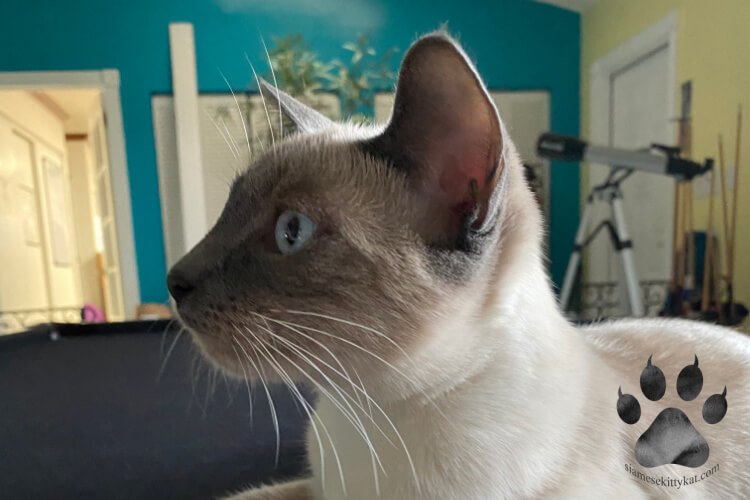Cats have one of the strongest hearing ranges among mammals. They can even hear better than us humans! They are better at spotting the difference between tones and pitches than we are.
I wondered when I discovered that a cat’s hearing is five times better than ours! How could an adorable cat, including the Siamese, have a superior sense of hearing?
Siamese cats can hear and follow even the quietest sounds. They amplify sound waves up to three times between 45-64,000 Hertz. They can move and rotate their ears to 180 degrees and improve their hearing to 20% to focus on the source of the sound.
We can’t move our ears much, but cats can turn and twitch them. They can move them all around thanks to the 32 muscles they have in their ears!
Batman, one of my Siamese cats, always looks for sounds at home. His ears point forward when he’s interested in listening to me. He immediately responds with meows when I call him.
Robyn, another kitty of mine, enjoys the sound of his favorite interactive toy. He always finds it fast when I hide it.
Read on to learn about the extraordinary hearing abilities of our feline friends!
How can Siamese cats hear?
Cats can find the exact location of the source of sounds because of the muscular anatomy of their ears. Did you know they have more muscles in each ear than dogs and humans? The 32 small muscles help them figure out exactly where sounds are coming from.
A Siamese cat can detect the tiniest squeak or rustle and know its precise location. Here’s how your cat hears sounds in order:
1. The cat captures sounds through the pinnae.
Cats have a unique detection mechanism because of their triangular and cone-shaped ears.
The shape of your cat’s outer ears helps him pick up sound waves fast. It also helps him amplify the sound as it travels to the middle and inner ear.
The hearing process begins with capturing sound waves through the pinnae. The pinnae are the visible exterior parts made of cartilage and covered with fur.
Siamese cats use their pinnae to catch sound waves and send them down the ear canal.
The pinnae can detect where the sound is coming from. Your cat’s pinnae can also move opposite ways to hear and catch sounds better.
2. The cat’s ear canal funnels the sound waves to the eardrum.
A cat’s ear canal is deeper and narrower than a person’s. A cat’s ear canal extends far downward, making it a better funnel for the sound waves to get to the eardrum.
One disadvantage is that dirt and wax accumulate fast in this part because it is so narrow. It may lead to inflammation or infection if it keeps building up.
3. The ossicles vibrate when the funneled sound waves hit the eardrum.
The sound waves come together in the middle ear. The middle ear has small bones called the ossicles. The ossicles move and vibrate when sound waves reach the eardrum through the funnels.
4. The vibration goes to the inner ear and sends electrical signals to the brain.
The sensory cells in the inner ear respond to vibrations. Sensory cells send electrical impulses to the brain through the auditory nerve. Housed also in the inner ear is the vestibular system.
The vestibular system helps establish spatial orientation. The vestibule helps your cat learn how to get to the sound they hear.
What does the position of my Siamese cat’s ears mean?
The position of your cat’s ears can reveal a wide range of emotions. A Siamese cat’s ears can convey his feelings along with his purr and tail language. Here are a few examples:
1. Your Siamese cat’s ears slightly shift when he is lively and happy. This movement indicates a cheerful mood and an excellent time to cuddle with your furry friend!
2. His ears point up when he is relaxed and wants to catch up on sleep.
3. He pulls his ears back when he feels overstimulated.
4. His ears are straight up when he is attentive and cautious.
5. His ears are flat against his head when he feels terrified or nervous.
6. His ears press flat against his head when he is uncomfortable or fed up with something you’re doing.
7. Your cat lowers his ears and turns them sideways when he feels irritated or angry. Watch out for your furry friend if he has this ear position. He might display aggressive behaviors.
8. His ears twitch and rotate in quick movements while hunting.
9. His ears protrude and hang down when he’s not feeling well.
10. Your cat’s ears lift and twitch when your cat is trying to figure out where a particular sound is coming from.
What is Henry’s pocket on a cat’s ear?
On the outside of the pinnae, cats have folds of skin that look like tiny slits. The folded skin looks like pouches. We call it “Henry’s pocket.”
Henry’s pocket helps a cat’s ears fold and makes it easier for him to hear high-pitched sounds. Yet, vets still don’t know what these pockets are for. Scientists call it a “cutaneous marginal pouch.”
Almost all domestic cats’ ears have Henry’s pocket. It is soft to touch and makes the cat’s ears look extra cute! Fun fact! Dogs also have it!
Some fascinating facts you should know about cats’ ears:

1. Cats are born with sealed ear canals and undeveloped auditory systems.
Your cat was not born with hearing! Cat’s ear canals open a few weeks after birth.
2. The ear canals of cats have a self-cleaning function.
Your cat doesn’t need much help in keeping his ears clean. Do not clean his ears unless they have an infection or problem.
3. A cat’s ears are essential to his balance.
Your cat’s ears have a vestibule that tells him whether he’s upside down, lying on his side, or about to fall. The semicircular canals in his ears prompt the correcting reflex. This reflex assists him in landing well before falling.
4. Some cats have four ears!
They have extra pinnae behind their normal pinnae. The four ears are the result of a genetic defect.
5. Cats can talk to other cats through their ears.
Your cat can talk to other cats in different ways. Your friendly kitty talks to them by meowing, purring, touching them, and using their ears.
6. Cats have some of the best hearing among domesticated animals.
They have one of the most potent and precise hearings among domesticated animals. They can even hear better than dogs.
7. Some cats lose hearing as they get older or sick.
Though this might happen, they are still good at hunting. Siamese cats have other strong senses they can rely on.
Do cats hear better than dogs?
Cats can hear better than dogs. They have a strong hearing sense and can hear at an ultrasound level. They can use their ears to help them hear sounds around them.
Dogs have a good sense of hearing, but cats still have it better. Compared to canines, felines’ hearing is more sensitive.
Do cats have the best hearing?
Cats hear better than you might think. Those perky ears come in handy! They can hear much better than we can, especially at higher frequencies. They can also hear about as low as we do! Along with mice, bats, and beluga whales, cats are among the animals with the best sense of hearing.
The table below shows the approximate frequency range of cats and other animals.
| Approximate Frequency Range for Hearing | ||
| Animal Type | Lower Limit | Upper Limit |
| Human | 64 Hz | 23,000 Hz |
| Dog | 67 Hz | 45,000 Hz |
| Cat | 45 Hz | 64,000 Hz |
| Mouse | 1,000 Hz | 91,000 Hz |
| Bat | 2,000 Hz | 110,000 Hz |
| Beluga whale | 1,000 Hz | 123,000 Hz |
Are Siamese cats prone to being deaf?

Siamese cats, especially as they age, may develop hearing problems.
What can cause them to lose their hearing? Aging is the most common reason. According to Vetwest, some cats show early signs of aging, such as deafness, between 7-11 years old.
Your cat’s eardrums become thicker as he ages. He might experience hearing loss due to age-related changes.
Ear infections like Otitis externa and nerve damage are possible causes, too! Cats suffering from hyperthyroidism are also prone to being deaf.
It might also be because of chronic infection. Your cat could have nerve damage and inner ear bone fusion.
Do Siamese cats respond to their names?
Siamese cats, especially domesticated ones, know their names. They also recognize their owners’ voices.
Researchers from the University of Tokyo investigated whether cats can recognize their names. They discovered that most of them perked up when they heard their names. Most cats responded by meowing, approaching, or moving their ears.
Do Siamese cats understand what we’re saying?
Siamese cats do not understand words. They can recognize voices, especially those of their human family, but they do not understand what you’re saying. Their brains understand language in quite different ways than ours.
Siamese cats try to understand your body language more than your words. They connect the words you say based on how you look at them and move your body. They figure out what you’re trying to say by looking at your facial expression and posture.
I talk to Batman and Robyn like they are little kids. They react to some words and don’t react to others.
These smart kitties have been with me for a long time. They know “treat,” “sit,” and “door” because they hear those words and see my actions over and over in their routine.
In general, Siamese cats recognize human language the way we interpret meowing. They respond to what we say, but that doesn’t mean they comprehend what we say.
Siamese cats are sensitive to sounds above and below the range of frequencies we can detect. They have a sense of hearing that surpasses both dogs and humans. Their ears are their hearing and balancing organs. It’s undeniable that Siamese cats have advanced hearing abilities! Thank you so much for reading!
We gathered all the health tips tailored toward maintaining your Siamese cat’s optimal well-being. Check it out here: Siamese Cat Health: A Complete Guide
Get your FREE Siamese Cat 2025 Printable Calendar

